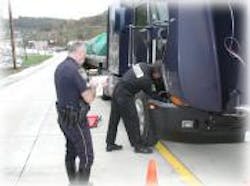"The Roadcheck campaign highlights the important work that commercial vehicle inspectors perform everyday to keep our roads safe and save lives. The number and the severity of crashes each year involving large trucks and buses is declining. We must not lessen our resolve to work together to make our highways and roads safer for every traveler.” –Rose McMurray, acting deputy administrator, Federal Motor Carrier Safety Administration
It’s an annual ritual every June or thereabouts: a 72-hour hour roadside inspection “blitz” conducted by thousands of safety inspectors across America on commercial trucks and buses of all makes and models.
Initially, it might seem foolhardy to broadcast to the highway community at large that such a widespread blitz is taking shape – including the very dates when it’s to occur, as in this case, where inspectors will be out in full force June 2 through 4, 2009. But the Commercial Vehicle Safety Alliance (CVSA), which helps sponsors this yearly event, doesn’t see it that way at all – and for some very good reasons.
“Effective enforcement comes in multiple facets – typically a mixture between overt as well as covert operations,” Steve Keppler, CVSA’s director of policy and programs, told me. “With ‘Roadcheck,’ there’s a certain group of fleets and drivers that’s going to see this coming up and say to themselves, ‘I better make sure my equipment is ready – that all my Ps and Qs are in order.’ If they are doing that, then we’ve already succeeded with this program, because the intent is to get the trucking community to tighten their focus on vehicle and driver safety.”
In that context, then, ‘Roadcheck’ is an educational outreach effort mixed in with safety enforcement; an attempt to reemphasize to fleets and drivers what is critical when it comes to safe operation on the highway. Yes, tickets are written, with trucks and drivers put out of service. But if these efforts result in greater safety consciousness by members of the trucking community – especially in terms of “getting ready” for such a nationwide blitz – then it’s been more than successful, Keppler said.
Last year, 9,148 CVSA and FMCSA certified inspectors at 1,683 locations across North America performed 67,931 truck and bus inspections, with 52,345 of them North American Standard Level I inspections – the most comprehensive type of roadside inspection. Keppler told me both the total number of inspections and Level I inspections were records for this annual Roadcheck event and – more importantly – there were significant reductions in out of service rates for most vehicle and driver types. That means the safety message is getting through, he emphasized.
This year, roadside inspectors will be focusing on several different fronts:
• The NAS Level I Inspection which examines all of the following: driver's license, medical examiner's certificate and waiver, alcohol and drugs (if applicable), driver's record of duty status (as required), hours of service, seat belt, vehicle inspection report, as well as the brake system, coupling devices, exhaust system, frame, fuel system, turn signals, brake lamps, tail lamps, head lamps, lamps on projecting loads, safe loading, steering mechanism, suspension, tires, van and open-top trailer bodies, wheels and rims, windshield wipers, emergency exits on buses and HM requirements, as applicable;
• Safety Belt enforcement;
• Motorcoach and bus safety compliance;
• Unified Carrier Registration (UCR) compliance: In 2005 SAFETEA-LU codified UCR into federal law. It replaced the Single State Registration System (SSRS) and all motor carriers – for-hire, private and exempt – as well as brokers, freight forwarders, and leasing companies operating in interstate or international commerce, are subject to the new UCR.
CVSA sponsors Roadcheck each year with the FMCSA, the Canadian Council of Motor Transport Administrators, Transport Canada, and the Secretariat of Communications and Transportation in Mexico.
Even more important, Keppler noted, are the instances where industry and inspectors are working together to better define safety parameters when it comes to equipment. During a recent visit to Arizona, Keppler said he found that several fleets are sending senior technicians out to the inspection areas to learn hands-on from the inspectors exactly what constitutes a passing or failing grade on equipment inspections.
“That’s an example of a fleet building a ‘safety culture’ as a call it – not just focusing on meeting the regulations, but trying to gain a deeper understanding of what they are for and why inspectors considering them important,” he told me. “Our number one goal with all these Roadcheck events is, of course, to enforce and improve highway safety, but as a secondary goal, we’re trying to foster more such ‘joint activity’ to help move the safety needle in the direction we need it to go with industry support.”
